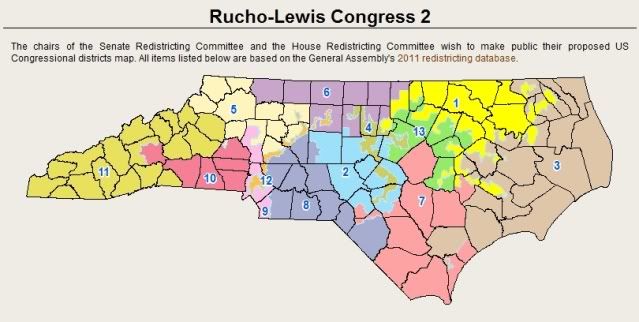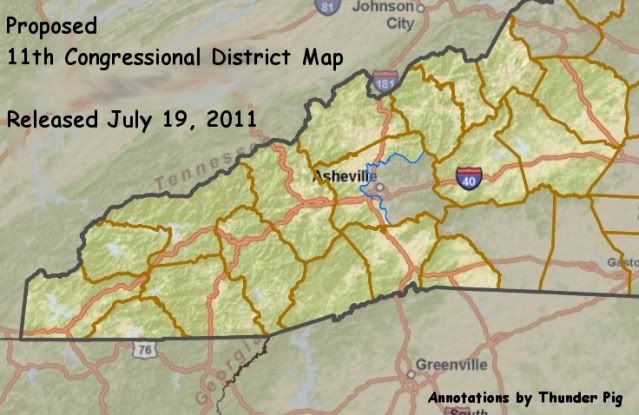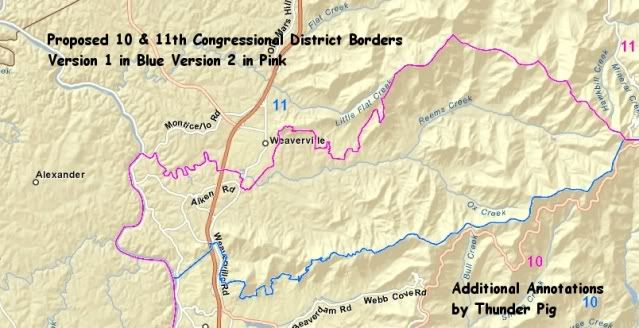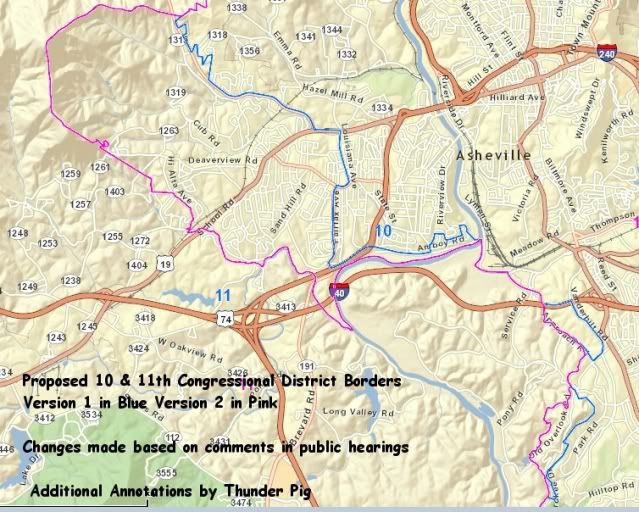
For more Information on this proposed map, see Rucho-Lewis Congress 2
Joint Statement of Senator Bob Rucho and Representative David Lewis
regarding the release of Rucho-Lewis Congress 2
On July 1, 2011, we released for public comment our first proposed Congressional Redistricting plan called “Rucho-Lewis Congress 1” (“Rucho-Lewis 1”). We believe that Rucho-Lewis 1 fully complies with all applicable federal and state legal requirements. On July 7, 2011, we held public hearings on Rucho-Lewis 1 and received many comments and suggestions regarding our initial proposed plan.
Today, we are pleased to release “Rucho-Lewis Congress 2” (“Rucho-Lewis 2”), which constitutes a revision of our original plan. We have made several changes in this second proposed Congressional plan based upon comments received during the public hearings, comments on the General Assembly’s website and feedback from members of Congress. One of our goals is to create more competitive Congressional districts. In fact, John Dinan, Professor of Political Science from Wake Forest University, prepared an unsolicited report explaining how our initial proposed plan creates more competitive districts than the existing 2001 Congressional plan. Dr. Dinan’s report is available for review on the General Assembly’s web page and its redistricting link.
As explained by Professor Dinan, claims that we have engaged in extreme political gerrymandering, similar to what exists in the current versions of the Thirteenth, Second and Eighth Congressional Districts, are overblown and inconsistent with the facts. For example, based upon the results of the 2008 General Election, Democratic Attorney General Candidate Roy Cooper would have carried twelve of thirteen districts in Rucho-Lewis 1 and all thirteen districts in Rucho-Lewis 2. In both of our proposals, registered Democrats are a majority in three congressional districts. There are no districts in which registered Republicans are a majority. In both proposals, registered Democrats outnumber registered Republicans in ten districts. Finally, in both proposals, the combination of registered Democrats and unaffiliated voters constitute a majority in all thirteen districts. Thus, in both of our proposals, there are three strong Democratic districts. There are also ten districts in which Democratic candidates have the potential to win, without a single Republican vote, provided they convey a message that appeals to their own registered Democrats and unaffiliated voters.
The changes found in Rucho-Lewis 2 stem in part from comments we received regarding our initial proposal for Congressman Butterfield’s First District. Changes we have made to the First District have had a rippling impact on most of the remaining districts. Some of our critics have suggested that the First District be eliminated from any new redistricting plan because of it shape. Those who have made this argument fail to understand that the 2011 General Assembly inherited the First District from prior General Assemblies and that prior General Assemblies enacted the First District in order to comply with Section 2 of the Voting Rights Act. For example, some of these same critics are apparently unaware that the shape of the First District has been approved by a federal district court as compliant with the minority population “compactness” requirement for districts drawn to avoid liability under Section 2 of the Voting Rights Act. Cromartie v Hunt, 133 F.Supp.2d 407,423 (E.D.N.C. 2000).
It would be legally imprudent to dissolve this district.
However, we cannot keep the 2001 version of the First District because of two flaws. First, the current First District is under-populated by over 97,000 people. Second, it does not include a majority black voting age population (“BVAP”), as required by Section 2 of the Voting Rights Act. See Strickland v. Bartlett, 129 U.S. 1231 (2009). Thus, any revision of the First District requires the addition of over 97,000 people. In addition, added population must include a sufficient number of African Americans so that the First District can re-establish as a majority black district.
Prior to our release of Rucho-Lewis 1, we discussed both of these problems with Congressman Butterfield. We believe that he understood and agreed that his district would be drawn into either Wake or Durham Counties to cure the district’s equal population and voting rights deficiencies. We understood that Congressman Butterfield preferred that his district be drawn into Wake County instead of Durham. We also discussed with Congressman Butterfield that drawing his district into Wake County may result in the withdrawal from his district of one or more counties covered by Section 5 of the Voting Rights Act. Our understanding of Congressman Butterfield’s preferences was reflected in our initial version of the First District found in Rucho-Lewis 1.
During our public hearings, several speakers expressed concerns about our decision to withdraw the First District from several counties covered by Section 5 of the Voting Rights Act. Despite these complaints, we have received only one other proposal that would bring the First District back to a majority black level. This sole proposed alternative drew the First District into Durham County instead of Wake. This proposal also included all of the Section 5 counties currently found in the 2001 version of the First District.
Following the public hearing, Congressman Butterfield issued a statement disputing our understanding of our prior discussions with him. Thus, as we now understand Congressman Butterfield’s position regarding revisions to the First District, it appears that he may have no preference between drawing his district into either Wake or Durham Counties. We also assume that Congressman Butterfield would support keeping the black population in Section 5 counties at similar or higher levels as compared to the amount of black population in Section 5 counties under the 2001 version of the First District.
Based upon this feedback, in Rucho-Lewis 2, we have drawn the First District into Durham County instead of Wake. There is historical precedent for a district that combines Durham with counties located in eastern North Carolina. Moreover, our revised version of the First District brings it up to ideal population with other districts and re-establishes it as a majority black district.
While our initial version of the First District was fully compliant with Section 2 and Section 5 of the Voting Rights Act, our second version includes population from all of the Section 5 counties found in the 2001 version of the First District. Moreover, the total BVAP located in Section 5 counties in Rucho-Lewis 2 exceeds the total BVAP currently found in the 2001 version.
Some of our critics have complained about the appearance of our proposed Twelfth District. Again, these critics fail to understand that we inherited District 12 from prior General Assemblies. Further, this district has been approved by the United States Supreme Court as a district lawfully drawn to elect a Democrat. Easley v Cromartie, 121 S.Ct. 1452 (2000). The District has also been precleared under Section 5 of the Voting Rights Act on at least two prior occasions.
In adopting the Twelfth District, we intended to accommodate the wishes expressed to us by Congressman Watt, as we understood them, to continue to include populations located in Mecklenburg, Guilford, and Forsyth Counties. Our revised version of this district makes it more compact and continues the district as a very strong Democratic district. Our revision of the Twelfth District is based upon whole precincts that voted heavily for President Obama in the 2008 General Election. We have been accused of illegally “packing” black voters into the Twelfth District and illegally “diluting” the “influence” of black voters. We have repeatedly asked our critics for any case law that supports these arguments and none has been provided. By continuing to maintain this district as a very strong Democratic district, we understand that districts adjoining the Twelfth District will be more competitive for Republican candidates.
###
Here are a few more maps detailing the changes in the 11th Congressional District:

The 11th Congressional District of North Carolina

Map of Asheville with Congressional District lines noted in pink
If you'll note, per comments made at the recent public hearings, more of Asheville is kept together, only in the 10th District.
here are a couple of maps with a little more detail on that:

North Asheville

West and South Asheville






























0 comments :
Post a Comment